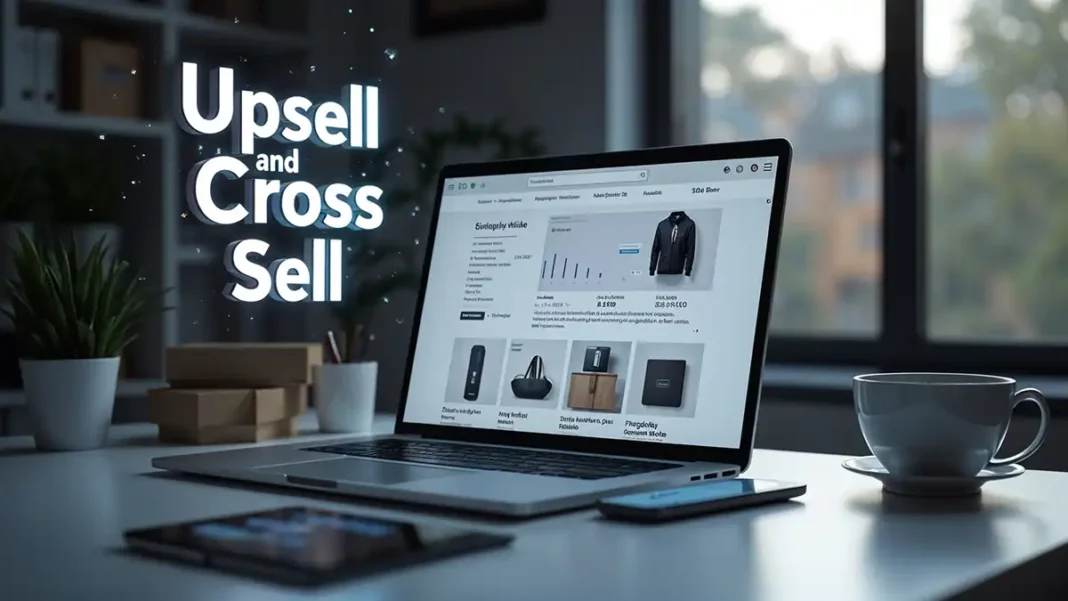Upsell and Cross-Sell, In the hyper-competitive world of e-Commerce, simply attracting new customers is no longer enough to guarantee sustainable growth. The cost of customer acquisition continues to climb, placing immense pressure on businesses to maximize every single interaction. Are you leaving significant revenue on the table by not maximizing the value of your existing customer base?
Imagine a powerful strategy that leverages your existing customer relationships to unlock exponential growth, turning one-time buyers into loyal, high-value patrons. In this article, you will gain a comprehensive understanding of effective Upsell and Cross-Sell strategies, learn how to implement them seamlessly into your e-Commerce operations, discover methods for boosting customer retention unlock the secrets to significantly increasing your Average Order Value (AOV).
The Cornerstone of Growth: Understanding Upsell and Cross-Sell
- At its heart, Upsell and Cross-Sell are two distinct, yet incredibly powerful, sales techniques designed to increase the value of each customer interaction. They are not about pushing unwanted products, but rather about enhancing the customer’s purchase or experience by offering more relevant solutions.
- Upselling refers to the strategy of encouraging a customer to purchase a more expensive, upgraded, or premium version of the product they are already interested in or have previously bought.
- The goal of upselling is to maximize the value of a single transaction by offering a superior alternative that better meets the customer’s needs or provides additional benefits. Think of it as guiding the customer towards a “better” version of what they already want.
- Cross-selling, on the other hand, involves offering a complementary product or service to a customer based on their current purchase or interest. The objective of cross-selling is to broaden the customer’s purchase by suggesting items that enhance the utility or enjoyment of their primary selection.
- This strategy focuses on making the customer’s overall experience more complete by providing everything they might need related to their main item. Both are crucial elements of a robust e-Commerce revenue growth strategy.
Why Upsell and Cross-Sell Are Your E-Commerce Superpowers
- In the dynamic landscape of e-Commerce, the ability to effectively Upsell and Cross-Sell translates directly into tangible business advantages, transforming them into veritable superpowers for your online store. Firstly, these strategies are significantly more cost-effective than customer acquisition.
- It’s a well-documented fact that acquiring a new customer can cost five times more than retaining an existing one. By focusing on increasing the value of existing relationships, businesses can achieve higher revenues without incurring massive marketing expenditures. This makes Upsell & Cross-Sell a lean, efficient growth engine.
- Secondly, the conversion rates for upselling and cross-selling are dramatically higher. Existing customers or those already in the buying journey are far more likely to convert on relevant offers than cold leads. They already trust your brand, understand your products are in a buying mindset.
- This inherent trust reduces sales friction and directly boosts your Average Order Value (AOV), leading to a healthier bottom line. For any e-commerce business striving for sustainable growth, mastering Upsell and Cross-Sell is not merely an option but a strategic imperative.
Masterful Upselling Strategies: Guiding Customers to Greater Value
Effective upselling isn’t about being pushy; it’s about being helpful and insightful, demonstrating genuine value. A key strategy is presenting a clear value proposition for the upgrade. It’s not just “buy the more expensive one,” but “buy this one because it offers X more benefits, which aligns perfectly with your stated need for Y.”
For instance, in Upsell and Cross-Sell
- If a customer is viewing a basic smartphone, upselling could involve showcasing a slightly more expensive model with a superior camera, longer battery life, or more storage features that resonate with typical smartphone user desires.
- Another powerful upselling technique involves tiered pricing models. Offering “Good,” “Better,” and “Best” options allows customers to self-select into a higher tier based on their budget and perceived needs. The “Best” option often looks more appealing when contrasted with a slightly less capable “Better” option.
Additionally, upselling can be achieved through extended warranties or service plans directly linked to the product. While the initial purchase might be a laptop, the upselling opportunity arises with an offer for an extended warranty or premium support, providing peace of mind and additional value to the customer. This considered strategy elevates the customer’s purchase experience while boosting revenue.
Artful Cross-Selling Tactics: Introducing Complementary Delights
- Cross-selling thrives on relevance and anticipation, offering products that genuinely enhance the customer’s primary purchase. A highly effective strategy involves showcasing complementary items directly on the product page or in the shopping cart.
- For example, if a customer adds a digital camera to their cart, cross-selling suggestions might include a memory card, an extra battery, a camera bag, or a tripod. These are items that are logically needed to make the camera fully functional or more enjoyable.
- Bundling complementary products at a slightly reduced price is another potent cross-selling tactic. This “bundle deal” creates a perception of added value and encourages the customer to purchase multiple items they might have bought separately anyway.
- Post-purchase cross-selling through email marketing is also highly effective. Once a customer has bought a product, a follow-up email recommending complementary accessories, maintenance kits, or related items for future needs can drive repeat purchases and build customer retention. This proactive strategy ensures customers feel supported and valued, extending the relationship beyond the initial sale.
Strategic Implementation: When and How to Execute Your Strategy- Upsell and Cross-Sell
- The timing and placement of your Upsell & Cross-Sell offers are as critical as the offers themselves. Integrating these strategies seamlessly into the customer journey ensures maximum impact without appearing overly aggressive. On product pages, subtle suggestions like “Customers who viewed this also viewed” or “Frequently bought together” banners work well for cross-selling by leveraging social proof.
- For upselling, displaying a comparison table of different product tiers can nudge customers towards a higher-value item.The shopping cart and checkout page are prime locations for both Upsell and Cross-Sell. Here, complementary add-ons like extended warranties, expedited shipping, or small, impulse cross-selling items (e.g., “Add a screen protector for just $X”) can be highly effective.
- Post-purchase communication via email is a fantastic long-term strategy for cross-selling, recommending items that will enhance the initial purchase or cater to future needs. The key is to make offers relevant, timely convenient, allowing customers to easily add them to their purchase. A well-thought-out strategy ensures these opportunities aren’t missed.
Beyond the Sale: The Role of Upsell and Cross-Sell in Customer Retention
- While Upsell and Cross-Sell are often viewed purely as revenue-boosting mechanisms, their profound impact on customer retention is frequently underestimated. When implemented thoughtfully, these strategies demonstrate a deep understanding of customer needs and preferences.
- By recommending truly complementary products or offering meaningful upgrades, you show customers that you value their long-term satisfaction, not just their immediate transaction. This personalization fosters a sense of trust and strengthens the customer’s bond with your e-commerce brand.
- A customer who feels understood and well-served is far more likely to return for future purchases and become a loyal advocate for your brand. Successful Upsell and Cross-Sell initiatives contribute to higher customer lifetime value (CLTV) not just by increasing individual transaction amounts, but by cultivating lasting relationships.
- This is a powerful strategy that turns a one-time buyer into a repeat customer, significantly enhancing customer retention and ensuring sustained business growth.
Measuring Success and Continuous Optimization in Your e-Commerce Journey: Upsell and Cross-Sell
- Implementing Upsell and Cross-Sell strategies is not a one-and-done task; it requires continuous measurement, analysis optimization. Key metrics to track include Average Order Value (AOV), conversion rates for upsell and cross-sell offers customer lifetime value (CLTV).
- A/B testing is an indispensable tool here, allowing you to experiment with different recommendations, placements, messaging pricing strategies to identify what resonates best with your audience. For instance, testing two different upselling headlines on a product page can reveal which one drives more upgrades.
- Leveraging e-Commerce analytics platforms and recommendation engines can provide invaluable insights into customer behavior, helping you refine your strategy. Understanding which complementary products are most frequently purchased together, or which upgrade paths are most popular, allows for data-driven decisions.
- The e-Commerce landscape is dynamic customer preferences evolve. Therefore, regular review and adaptation of your Upsell & Cross-Sell tactics are crucial for maintaining their effectiveness and continually boosting your revenue.
Conclusion: Mastering the Art of Growth with Upsell and Cross-Sell
In the competitive digital marketplace, mastering Upsell and Cross-Sell is no longer a luxury but a fundamental requirement for sustainable e-commerce growth. These powerful strategies, when executed thoughtfully and with a keen understanding of customer needs, transform mere transactions into valuable, long-term relationships.
By strategically offering relevant upgrades and complementary products, you not only unlock significant untapped revenue potential but also enhance customer satisfaction and significantly boost customer retention. Embrace the art of Upsell & Cross-Sell as a core strategy for your e-Commerce business ,watch as your average order value soars, your customer relationships deepen your growth trajectory stabilizes for the long haul.
FAQ
What is the fundamental difference between Upsell and Cross-Sell?
Upselling encourages buying a more expensive version or upgrade of a product, while cross-selling suggests buying a complementary product that enhances the original purchase.
Why is upselling often easier than acquiring new customers?
Upselling is easier because it targets existing customers or those already committed to buying, leveraging their established trust and buying intent, which is more cost-effective than finding new leads.
What are the common mistakes to avoid in a cross-selling strategy?
Avoid recommending irrelevant or too many items, being overly aggressive, or offering items that aren’t genuinely complementary to the primary purchase.
How does personalization impact the effectiveness of Upsell & Cross-Sell?
Personalization significantly boosts effectiveness by tailoring offers based on a customer’s Browse history, past purchases preferences, making the suggestions more relevant and appealing.
Can Upsell and Cross-Sell truly improve customer retention?
Yes, by providing more value and demonstrating an understanding of customer needs through relevant offers, these strategies foster satisfaction and loyalty, leading to better customer retention.
What’s the best time to present an upsell offer?
The best times for upselling are typically on the product detail page (showing comparisons) or just before the final checkout, offering a “better” version of the item.
How quickly can e-commerce businesses see results from implementing these strategies?
Businesses can often see immediate boosts in Average Order Value (AOV) and conversion rates within weeks of implementing well-designed Upsell and Cross-Sell strategies.
Also Read:
Future Business Ideas: Check Out These Popular Ideas!
David William comes from an Engineering background, with a specialization in Information Technology. He has a keen interest and expertise in Web Development, Data Analytics, and Research. He trusts in the process of growth through knowledge and hard work.


